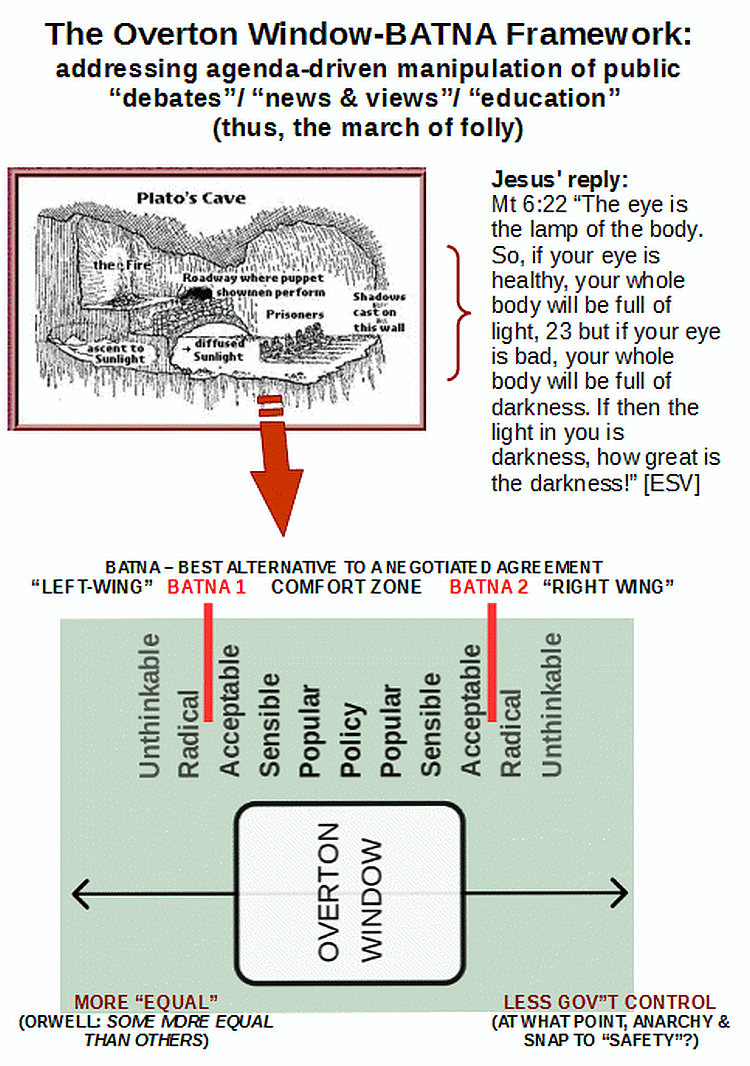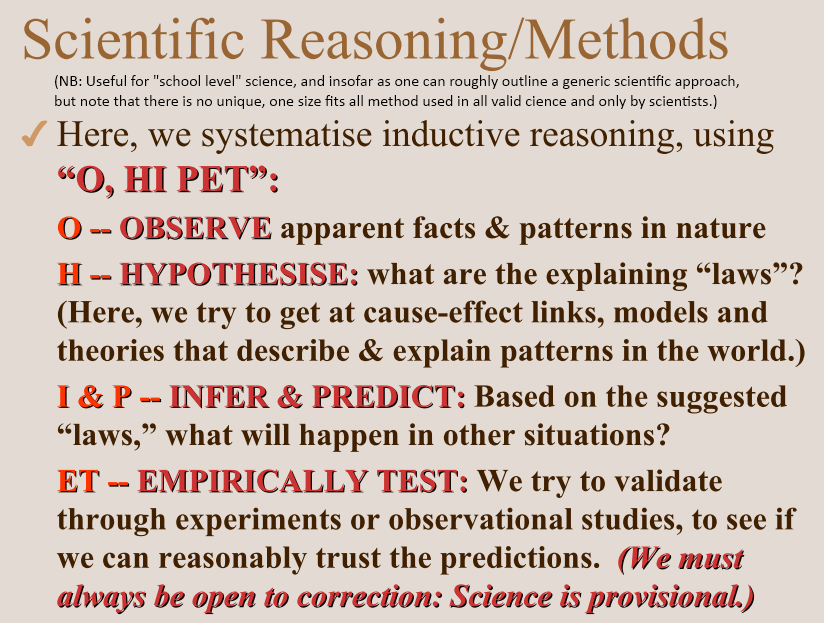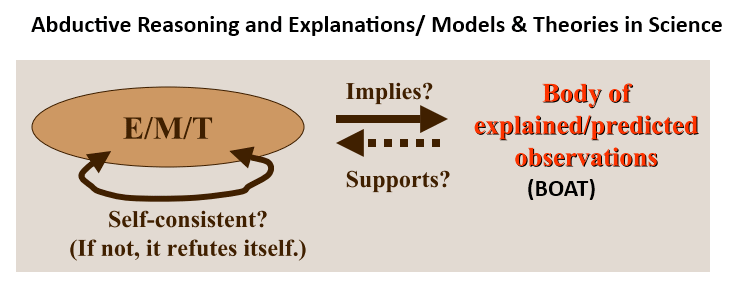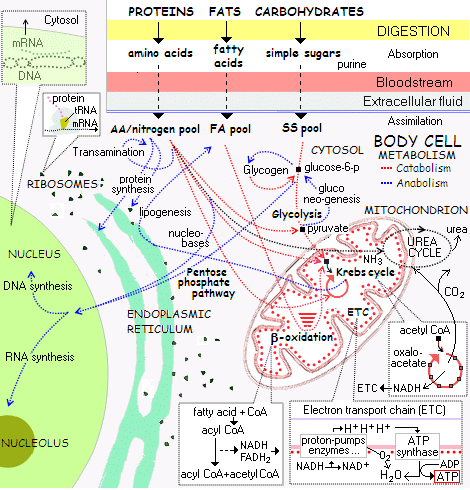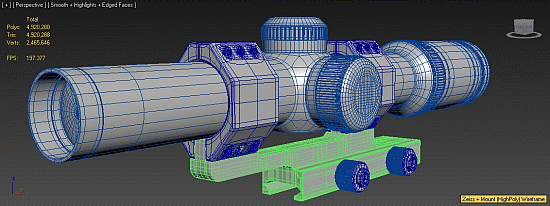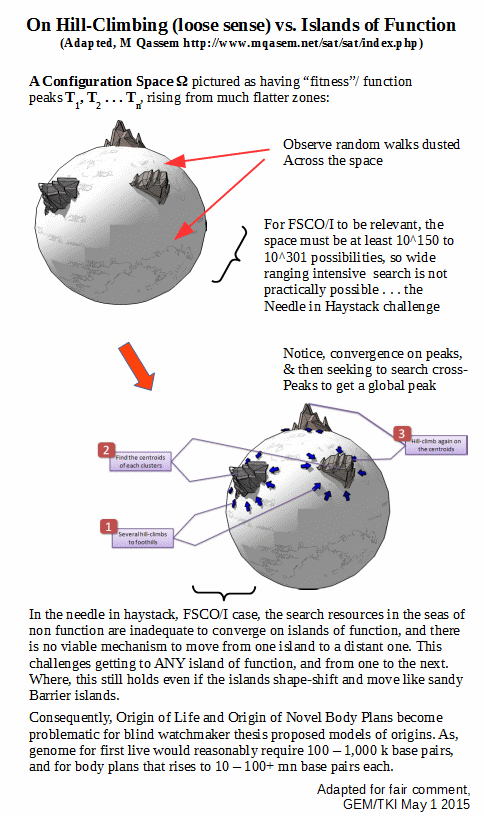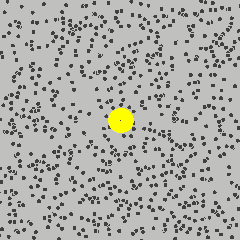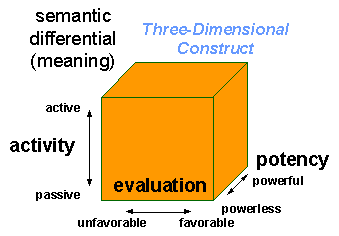The parable of Plato’s Cave in The Republic — vid:
[youtube d2afuTvUzBQ]
. . . is a classic point of departure for discussions of true vs false enlightenment, education, worldviews, liberty and manipulative sociocultural agendas or power games that open up marches of folly. ( I think Acts 27 still has the best classical case study on how democratic polities and/or decision makers can all too easily be led into such ill advised marches.)
March of folly?
Yes:

Of course, with a US Election cycle in full swing as the number one media story for the year, such is obviously highly relevant to anyone interested in public policy or geostrategic issues. But, these issues are also highly relevant to the debates that surround origins; not least because objectors to the design inference too often try to paint supporters of ID as right wing, theocratic creationists — who must therefore be “ignorant, stupid, insane (or wicked . . .)” — of course, dressed up in cheap tuxedos. Hints of terrorism in echo of the Islamists, and/or of Torquemada are also there.
However, as Aristotle warned in The Rhetoric, Bk I ch 2:
“Of the modes of persuasion furnished by the spoken word there are three kinds. The first kind depends on the personal character of the speaker [ethos]; the second on putting the audience into a certain frame of mind [pathos]; the third on the proof, or apparent proof, provided by the words of the speech itself [logos]. Persuasion is achieved by the speaker’s personal character when the speech is so spoken as to make us think him credible . . . Secondly, persuasion may come through the hearers, when the speech stirs their emotions. Our judgements when we are pleased and friendly are not the same as when we are pained and hostile . . . Thirdly, persuasion is effected through the speech itself when we have proved a truth or an apparent truth by means of the persuasive arguments suitable to the case in question . . . “
A grim warning, spoken with the ghost of Socrates standing at his shoulder.
If we are to come to a balanced, sound and truly enlightened view, we must needs understand the relevant dynamics at work in our time. Accordingly, I think the Overton Window model and the BATNA concept from negotiation theory are helpful:
Here, the idea is that a community typically has a comfort zone (which we like to think strikes a happy and “moderate” medium), which defines a range of acceptable views, proposals and policies. Things outside that window will be perceived as too radical and/or unacceptable.
And of course the spin-meisters are ever at work to push/pull one or the other BATNA points in ways that suit their paymasters and/or agendas.
That is what “mainstreaming” (in large measure) is about, and it is what drives “astroturfing” that creates a false sense of “grassroots” support as well as the desensitising/ glamourising the (formerly) distasteful/ obscene . . . or just plain bizarre. And the linked, more ruthless media message dominance jamming out of opposition or questioning that prevails with more radical agendas — once they scent victory. Beyond that (as the 1930s demonstrated) lie show trials in kangaroo courts, gulags and death camps.
You will also note that I have put in “left” and “right” wings, in more or less the terms they self-understand. My own view — and i/l/o various objections, pardon the difficulties of a 3-D scale on axes of state power, lawfulness and leadership, with anarchic breakdown at one end of each — is that these terms are much less meaningful these days than an analysis on degree of control that sees a sweet spot of limited, genuinely constitutional democratic self-government (or at least the lawful state) in the middle forming an inherently unstable equilibrium of degrees of state power, lawfulness and leadership/governance culture:
Such is of course of general interest, but applies particularly to the debates, media message dominance tactics, activism (and astro-turfing), policy agendas and general tone of the issues surrounding the design inference.
As the issue is too often distorted, let us remind ourselves of the per aspect form of the design inference explanatory filter:
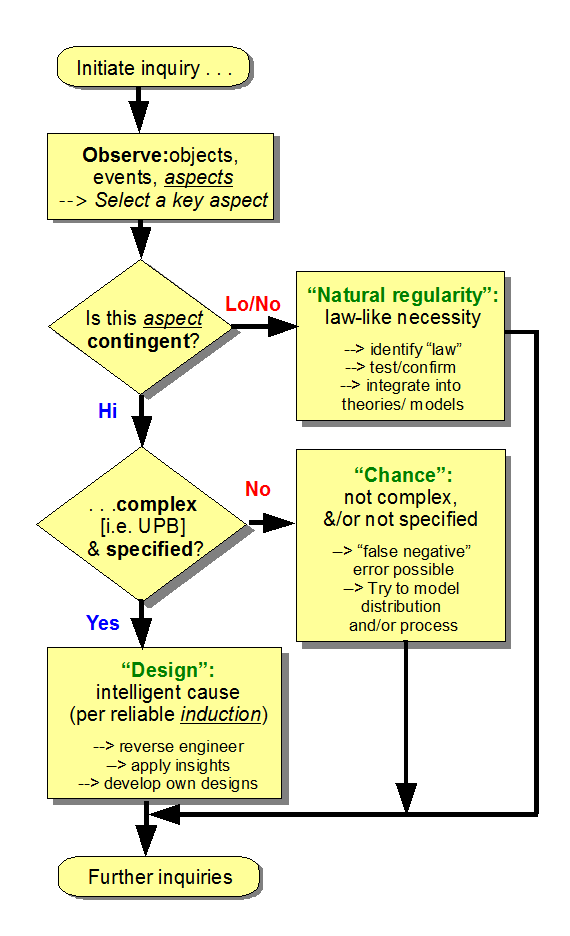 The pivot of this filter is the premise that in scientific reasoning and work, we often make abductive inferences to the best current, empirically grounded explanation . . . I here give the simple “O, HI PET” framework I developed for and have used in the classroom:
The pivot of this filter is the premise that in scientific reasoning and work, we often make abductive inferences to the best current, empirically grounded explanation . . . I here give the simple “O, HI PET” framework I developed for and have used in the classroom:
. . . in light of competing possible explanations and links to a body of [currently] accepted theory (BOAT):
It is important to understand that we live in a day in which many institutions are dominated by naturalistic, evolutionary materialistic scientism, and so the stamp of approval of “Scientific Consensus” carries great weight. [Never mind, properly conducted science is inherently provisional and open ended in its methods, findings, explanatory models, predictions, conclusions and recommendations — that tends to be forgotten in the push for message and policy dominance.]
With this in hand, we may readily see:
1 –> The tendency to tag ID thinkers and supporters as “Creationists” and then to smear and dismiss both as ignorant, stupid, insane and/or wicked, is little more than polarising rhetoric in support of controlling, manipulative agendas that wish to exclude and domineer rather than reason.
2 –> Such should long since have been stopped (and frankly, Mr Dawkins and NCSE et al have long owed a public apology . . . ), and those who insist on such tactics should stand exposed as acting in disregard to truth, fairness, fact and civility. Let is set such aside.
3 –> Similarly, the particularly pernicious tactic of crying “Gish gallop” — i.e. dismissal by insinuating a flood of distortions, half truths and misrepresentations without providing substantiation when a case is presented on a wide array of evidence should cease. Dr Gish won hundreds of debates on record by pointing out serious, systematic gaps in the fossil record and a pervasive lack of an adequate, empirically warranted blind watchmaker chance and/or necessity mechanisms for body plan origin by [neo-]Darwinian or similar means. That was so in the 1970’s and 80’s, leading to the rise of punctuated equilibria, and it remains so today, whether or not one is inclined to give much credence to his young earth creationist views.
4 –> Further to this, functionally specific, complex organisation and/or associated information (FSCO/I) is real and readily observable — the text of this post and comments will be cases in point (s-t-r-i-n-g data structures) . . . as are an Abu 6500 C3 reel:
. . . the process-flow network of an oil refinery:

. . . the cell’s metabolic network:
. . . and the protein synthesis mechanism in that network [top, left]:

4 –> Such systems are inherently highly contingent [the parts can be clumped or scattered in many possible ways) based on wiring-diagram, functionally specific arrangements of nodes and arcs familiar from engineering praxis.For example:
5 –> Their complexity can be measured by in effect listing a structured framework of yes/no questions that describe the network (similar to CAD software); where, once we hit a threshold of 500 – 1,000 bits [binary digits] — configuration spaces of scope 3.27*10^150 or 1.07*10^301 possibilities from 000 . . . 0 to 111 . . . 1 — the implied scope of blind watchmaker search in the relevant haystack will readily overwhelm scopes of 10^57 atoms (Sol system) or 10^80 atoms (observed cosmos), 10^17 s (~10 bn y) and 10^12 – 14 actions/s (comparable to fast chem reaction rates).
6 –> It can be readily seen, by contrast, that FSCO/I rich configurations by the very necessity of particular arrangement to reach function, will naturally come in relatively narrow clusters in configuration spaces — islands of function:
7 –> Thus there is first a challenge to find islands in the midst of seas of non function, and secondly, a hill-climbing challenge:
8 –> This speaks to the origin of life also, where in a Darwin pond etc, there will only be physics and chemistry to appeal to, in the context of statistical mechanics’ analysis of the underlying molecular-atomic behaviour:
. . . yielding the laws of thermodynamics (which are abductively inferred best explanations) and linked patterns of energy conversion and work, e.g. the heat engine:
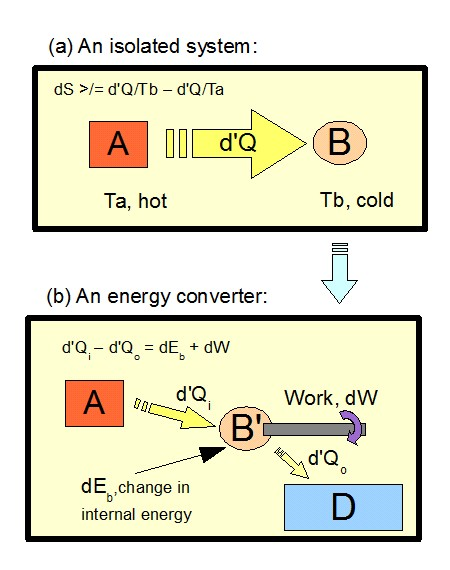 9 –> Where, it is a general observation on a trillion member observation basis, that FSCO/I rich structures and systems are seen to come from energy conversion and coupling to give shaft or flow work that is then put into an assembly process under a wiring diagram.
9 –> Where, it is a general observation on a trillion member observation basis, that FSCO/I rich structures and systems are seen to come from energy conversion and coupling to give shaft or flow work that is then put into an assembly process under a wiring diagram.
10 –> To date, there are no actually credibly observed exceptions to this pattern that FSCO/I reliably comes form intelligently directed configuration, aka design. That is, inductively, FSCO/I is at least as reliable a sign of design as deer tracks in a relevant context are of deer:

11 –> This then extends to the need to explain the class of system we have to deal with in life forms, von Neumann, kinematic self replicators [vNSRs] with considerable construction involved:
 12 –> When it comes to origin of body plans, much the same challenge obtains, e.g. to explain the origin of the brain as a key structure with considerable progammed content:
12 –> When it comes to origin of body plans, much the same challenge obtains, e.g. to explain the origin of the brain as a key structure with considerable progammed content:
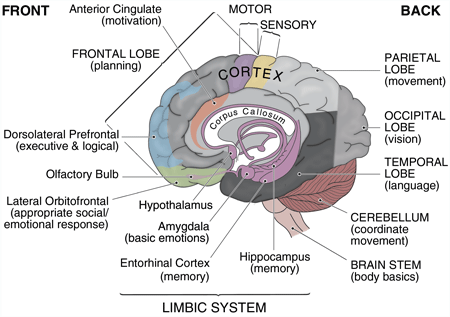 . . . that works based on neural networks:
. . . that works based on neural networks:

____________
As a consequence, the design inference needs to be addressed on an empirical, inductive, observationally anchored basis, not by trying to recategorise it rhetorically as a religious agenda and dismissing based on in effect strawman tactic prejudice.
But, in a deeply polarised ideologically dominated, Overton Window spin-game era, that is a big challenge. One, we need to face squarely. END
PS: As there seems to be a fixation on a 3-D scale I used above, here is a similar case:
